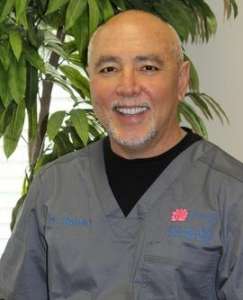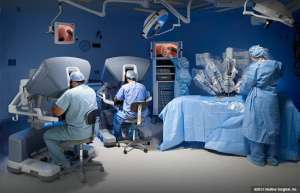The PREG Doctors answer questions related to infertility:

Reproductive Endocrinologist and Infertility Specialist
PREG Founder
Medical & Laboratory Director
Dr. Nichols answers questions about Da Vinci Robotic surgery
What are the advantages of using the Davinci robot for surgical cases?
What has happened in surgery over the last 40 years is incredible! Back in the day when we had to perform abdominal or pelvic surgery, a large incision was made and we would open the patient up and fix or repair the problem(s) and the patient would remain in the hospital for several days and incur a longer post-op recovery period. What has happened now, with the advent of laparoscopy, is the ability to do minimally invasive surgery with a small scope placed inside the abdomen to visualize the pelvic organs. With the small scope inside and with 2-3 other small incisions, we can put instruments/graspers/scissors inside the abdomen to treat or correct any abnormalities. We can remove cysts, fibroids, damages tubes, ovaries, endometriosis, adhesions or scar tissue laparoscopically. In addition, the patients’ surgery can be done as an outpatient (goes home the same day of surgery), cutting back on their medical bills and time of recovery. Patients can return to work or resume normal activities much faster than they could with an open or large incision surgery. Now with the Da Vinci robotic platform, we are able to do even more complex minimally invasive surgeries!
Why was this so important?
Well, with large open surgery you had more room to work in but were limited in what you could see and do and recovery time is much longer. Laparoscopy has reduced the size of the incisions as well as hospitalization time. However, you are still leaning over the patient as you operate with the laparoscope which can be hard on the surgeons over time. In addition, you have to use straight stick instruments (graspers/scissors) to perform procedures but those types of rigid instruments with limited movements can hinder the ability of some of the surgical procedures to be done easily. The DaVinci Robot allows you to make the same type of incisions and then adds in better visualization and increase in the movement of the surgical instruments and allowing one to perform more precise surgery, so in the end, robotic surgery is even better for both the patient and the surgeon!
How does it work?
The DaVinci Robotic surgery system allows the surgeon to put instruments in that attach to the robotic arms. While it’s similar to laparoscopy, with robotics, we can do more things through these same small incisions. The robot is more agile and mobile. The instrument moves with the robotic arm in the way the surgeon moves his fingers while sitting down at the console. It reduces or eliminates the awkward movements from laparoscopic surgery where you are standing over the patient’s side at OR table. It also eliminates hand cramps, any tremors and significantly increases the ability to totally see what’s going on with the use of the stereoscopic lens allowing a 3D image during surgery. The robot has added a whole different performance dimension for the surgeons. We are able to be more precise and meticulous in surgery with the same type of laparoscopic platform. The DaVinci Robotic System takes it up another notch. Where laparoscopy was a boost to open surgery to level 2.0 the robot has taken laparoscopic surgery to 3.0!
Do you still perform laparoscopic surgery?

What other procedures do you use the DaVinci Robotic for?
We use it to treat moderate to severe endometriosis, which can cause lesions in the pelvis that cause inflammation, irritation, and adhesions and can increase the risk of chronic pelvic pain and infertility. You can more easily remove these endometriosis lesions, which can be attached to the bowel, bladder, uterus, ovaries and pelvic lining, much easier and more precise with the use of robotic assistance.
Is this the future wave of surgery?
I think what we are going to see in the future is that a majority of surgeries will be done robotically. So much is now being done now from intricate surgery on kidneys, prostatectomies, bowel resections and much more. There is so much dexterity with the robot that we did not have with open surgery and even laparoscopies. Things like suturing of tissues and meticulous dissection work are much easier with robotics. The Da Vinci System is being used for cancer, lung, heart, ENT, GYN, bowel and brain surgery for example. I think in the near future, 80% or more of all surgeries will involve some type of robotic platform.
Should we fear AI and the rise of the machines?
Oh no, the surgeon is in control the entire time and the robot cannot do anything on its own. It’s really robotic-assisted surgery because the robot is assisting you in doing the surgery and allows the surgeon to have more dexterity and movements and to be able to work in small spaces. It also cuts down on surgeon fatigue because you are sitting down at a console and operating and looking through eyepieces and using your hands to do more difficult procedures over time, Even after a lengthy surgery, you feel so much less discomfort as you did when you were doing surgery leaning over the patient with standard laparoscopy. So, with a minimally invasive procedure using robotic assistance, it allows for quicker recovery with little to no time in the hospital and better surgical preciseness and less surgeon fatigue. It’s a win-win!
How does it specifically apply to your surgeries?
Let’s say you have a patient with three to four large fibroids undergoing open surgery. It requires a big incision and hospitalization. In contrast, the robotic surgery can take an hour or so longer to perform than the open procedure but the incisions are very small in comparison and result in fewer complications and adhesion formation with essentially no hospitalization which then speeds up the recovery time. In cases of endometriosis, the robot allows you to see lesions you can’t otherwise see because you are getting two to four times the magnification with the incredible visual optics. It allows us to go behind the uterus and in difficult areas to access and see lesions and angles you are unable to see with open surgery.
In most cases, you are also working with a dedicated team of robotic surgery assistants which is a more specialized training than other types of surgery. These dedicated teams provide skilled assistants and allow the surgeon to stay on the console while operating and focus on the view and movement of the arms and equipment.
PREG has offices in Greenville, Spartanburg, Asheville, and Columbia. We offer highly personalized fertility care and management. Dr. Nichols is based in Greenville, SC, office. For more information on reproductive options call, or contact us today at 866.725.7734, or online at http://www.pregonline.com/contact-us.php

Reproductive Endocrinologist & Founder
PREG
Image: AARP



